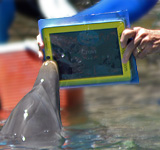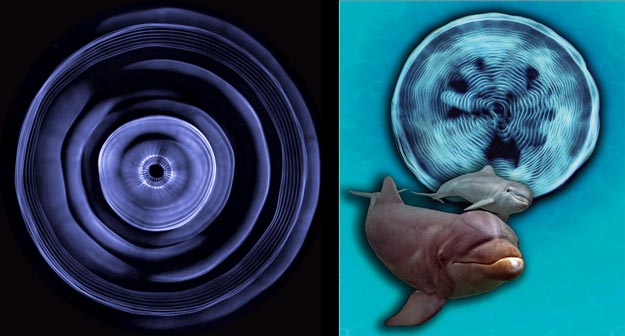It has long been a focus of scientific research to decode the language of dolphins. Having a brain about the same size as a human being, it is believed that learning how to understand their language will give us an opportunity to communicate with another species comparable to our level of development.
Using sophisticated sound technology, researchers are getting much closer.
Below are excerpts from several press releases from www.speakdolphin.com whose mission is to support research toward expanding communication between dolphins and humans.
1. PRESS RELEASE: Deciphering Dolphin Language with Picture Words
“In an important breakthrough in deciphering dolphin language, researchers in Great Britain and the United States have imaged the first high definition imprints that dolphin sounds make in water.
The key to this technique is the CymaScope, a new instrument that reveals detailed structures within sounds, allowing their architecture to be studied pictorially. Using high definition audio recordings of dolphins, the research team, headed by English acoustics engineer, John Stuart Reid and Florida-based researcher, Jack Kassewitz, has been able to image, for the first time, the imprint that a dolphin sound makes in water. The resulting “CymaGlyphs,” as they have been named, are reproducible patterns that are expected to form the basis of a lexicon of dolphin language, each pattern representing a “picture word.”
Left: cymaglyph of adult dolphin’s voice, Right: cymaglyph of a baby dolphin calling to its mother”
http://www.speakdolphin.com/ResearchItems.cfm?ID=6
2. Dolphin Language Analysis
“Our state-of-the-art digital recording capabilities allows us to capture the complete audio spectrum of dolphin vocalization and echolocation. Therefore we are scientifically assessing and analyzing dolphin vocalization and echolocation in ways that were impossible only a few years ago. Within these recordings we have discovered an astounding pattern of melodic modes which are unique to each dolphin and are equivalent to musical notes and chords. These “songs” are beautiful, yet, so complex that the human ear cannot decipher them without the aid of technology. To help the human ear make sense of these complex dolphin sounds, we have musicians play these musical patterns or “dolphin songs”, which are available on our Dolphin Code CD.
We are also in the process of creating an innovative system of written notation for transcribing the unusual qualities inherent in the inh2idual notes produced by dolphins.
Human definitions of language require speech (the signals we use), syntax (the structure we use), and semantics (the signals we use). Researchers must consider the possibility that dolphins may possess a language of tones, inflections, and timing found in languages like Chinese and the whistling language of the Silbo Gomera of the Canary Islands. We believe the discoveries that we have made point to the possibility of a robust language that developed on a different, but tangential, evolutionary path. It is quite possible that the human definition of “language” will have to broaden in order to encompass the dolphins’ use of language.”
http://www.speakdolphin.com/ResearchItems.cfm?ID=14
3. Press Release – Dolphin’s iPad
 “May 23, 2010 – Puerto Aventuras, Mexico at Dolphin Discovery
“May 23, 2010 – Puerto Aventuras, Mexico at Dolphin Discovery
Last week, a young bottlenose dolphin named Merlin became the first of his species to join the growing number of enthusiasts using the Apple iPad. Dolphin research scientist, Jack Kassewitz of SpeakDolphin.com, introduced the iPad to the dolphin in early steps towards build a language interface.”
